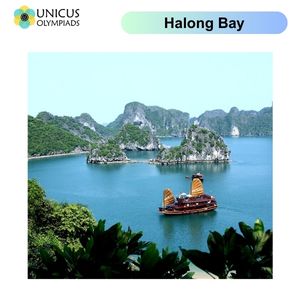

Ha Long Bay is one of the most stunning natural wonders in the world, renowned for its breathtaking scenery, rich biodiversity, and cultural significance. Located in the northeast of Vietnam, Ha Long Bay has become a symbol of the country's natural beauty and is a UNESCO World Heritage Site. This article will explore the unique features of Ha Long Bay, its cultural and ecological importance, and what makes it one of the most famous and visited tourist destinations in Asia.

Ha Long Bay is located in the Gulf of Tonkin in northeastern Vietnam, about 170 kilometers (105 miles) east of the capital, Hanoi. The bay is part of Quang Ninh Province and spans an area of approximately 1,553 square kilometers (600 square miles). The bay is renowned for its emerald waters and more than 1,600 limestone islands and islets that rise dramatically from the Gulf of Tonkin.
The islands and islets in Ha Long Bay are mostly uninhabited and feature dramatic karst formations. The towering limestone pillars are the result of millions of years of geological processes, including erosion, creating a landscape that is both unique and spectacular. The bay is often described as resembling a “dragon descending into the sea,” and its name, “Ha Long,” translates to "Descending Dragon" in Vietnamese, a reference to an ancient legend.
In 1994, Ha Long Bay was designated as a UNESCO World Heritage Site due to its exceptional natural beauty and geological importance. The site is recognized for its impressive limestone karst landscape, which is a rare and spectacular feature in the world. Ha Long Bay’s protected status highlights its value to global biodiversity and its importance to the history of the planet’s natural heritage.
Ha Long Bay was granted World Heritage status under the UNESCO criteria for natural sites, particularly for its outstanding universal value. The bay is known for its dramatic seascape, which consists of thousands of limestone islands and islets that are home to diverse ecosystems. Its geological formations provide a glimpse into the Earth’s natural processes, making it a site of global scientific and educational significance.
Ha Long Bay is steeped in local myths and legends, with the most famous story being the Dragon Legend. According to Vietnamese folklore, a dragon descended from the heavens to help defend the Vietnamese people from invaders. As the dragon flew down to the sea, its body created the towering limestone peaks that now make up the bay's islands. The dragon’s tail, as it swept through the water, formed the surrounding waters of Ha Long Bay, creating a natural barrier that protected the coastal areas from enemies.
In addition to the dragon legend, the bay is also associated with various local myths, including stories of fishermen and seafaring communities. The mystical qualities of the bay, combined with the natural beauty of the area, have made it a source of inspiration for local poets, artists, and storytellers for generations.
Ha Long Bay is famous for its limestone karst formations, which rise out of the sea in dramatic, jagged peaks. The islands vary in size and shape, some of which are just small rocky islets, while others are large enough to feature caves, beaches, and forests. The bay's surreal beauty, with its emerald-green waters and towering limestone cliffs, has made it one of the most popular tourist destinations in Vietnam.
Ha Long Bay is home to a diverse range of ecosystems, both marine and terrestrial. The bay is home to numerous species of plants and animals, many of which are endemic to the region. The surrounding islands support tropical forests, which provide a habitat for various species of birds, reptiles, and mammals. The marine life in the bay is equally diverse, with coral reefs, fish, and other aquatic species thriving in its waters. Ha Long Bay is a vital ecosystem, and its biodiversity makes it an important area for environmental conservation.
Beyond its natural beauty, Ha Long Bay is also a site of cultural significance. The bay has been a center for fishing, trade, and cultural exchange for centuries. The floating fishing villages on the bay are home to generations of fishermen who live and work on the water, continuing traditional ways of life that have existed for hundreds of years. The cultural practices of these communities are a valuable part of the bay's heritage, adding an additional layer of significance to the site.
Ha Long Bay is also home to several floating villages where local fishermen live and work. These villages are a testament to the adaptability and resilience of the local communities, who have lived on the water for generations. Visitors can take guided tours of these villages, learning about traditional fishing techniques, local crafts, and the unique way of life that has persisted in the region for centuries.
Ha Long Bay faces several environmental challenges, including the impact of tourism, overfishing, pollution, and climate change. The increasing number of visitors to the area has raised concerns about the preservation of the bay’s natural beauty and biodiversity. The local government and international organizations are working to address these issues by promoting sustainable tourism practices, limiting the number of visitors, and implementing environmental protection policies.
In recent years, there have been efforts to protect Ha Long Bay’s ecosystems. The Vietnamese government, in cooperation with UNESCO and environmental organizations, has implemented measures to reduce pollution and prevent damage to the coral reefs and marine life in the bay. Additionally, the government has worked to promote sustainable fishing practices and protect the livelihoods of local communities. Ongoing conservation efforts aim to ensure that Ha Long Bay remains a natural wonder for future generations to enjoy.